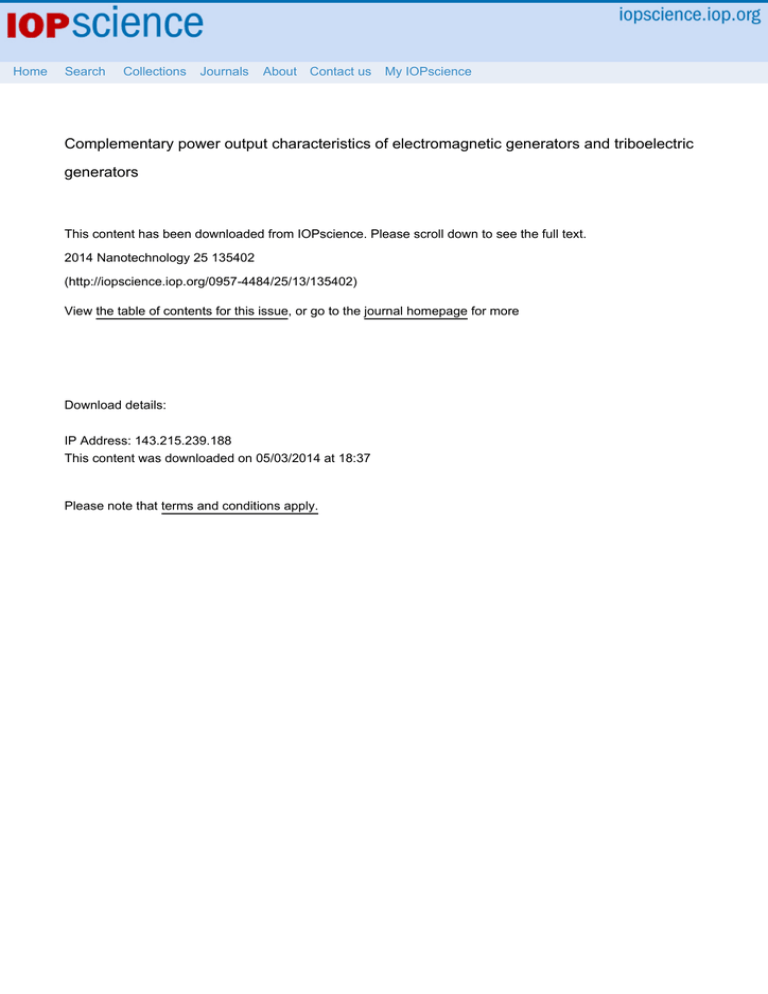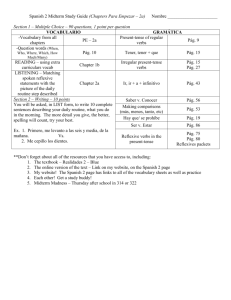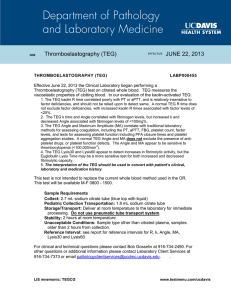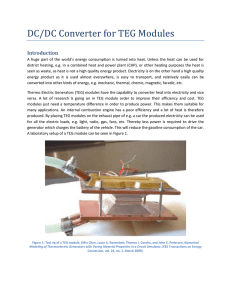Complementary power output characteristics of
advertisement

Home Search Collections Journals About Contact us My IOPscience Complementary power output characteristics of electromagnetic generators and triboelectric generators This content has been downloaded from IOPscience. Please scroll down to see the full text. 2014 Nanotechnology 25 135402 (http://iopscience.iop.org/0957-4484/25/13/135402) View the table of contents for this issue, or go to the journal homepage for more Download details: IP Address: 143.215.239.188 This content was downloaded on 05/03/2014 at 18:37 Please note that terms and conditions apply. Nanotechnology Nanotechnology 25 (2014) 135402 (7pp) doi:10.1088/0957-4484/25/13/135402 Complementary power output characteristics of electromagnetic generators and triboelectric generators Feng-Ru Fan1,2 , Wei Tang1 , Yan Yao1 , Jianjun Luo1 , Chi Zhang1 and Zhong Lin Wang1,3 1 Beijing Institute of Nanoenergy and Nanosystems, Chinese Academy of Sciences, Beijing 100083, People’s Republic of China 2 Collaborative Innovation Center of Chemistry for Energy Materials, Xiamen University, Xiamen 361005, People’s Republic of China 3 School of Material Science and Engineering, Georgia Institute of Technology, Atlanta, GA 30332, USA E-mail: zlwang@gatech.edu Received 21 December 2013, revised 23 January 2014 Accepted for publication 29 January 2014 Published 4 March 2014 Abstract Recently, a triboelectric generator (TEG) has been invented to convert mechanical energy into electricity by a conjunction of triboelectrification and electrostatic induction. Compared to the traditional electromagnetic generator (EMG) that produces a high output current but low voltage, the TEG has different output characteristics of low output current but high output voltage. In this paper, we present a comparative study regarding the fundamentals of TEGs and EMGs. The power output performances of the EMG and the TEG have a special complementary relationship, with the EMG being a voltage source and the TEG a current source. Utilizing a power transformed and managed (PTM) system, the current output of a TEG can reach as high as ∼3 mA, which can be coupled with the output signal of an EMG to enhance the output power. We also demonstrate a design to integrate a TEG and an EMG into a single device for simultaneously harvesting mechanical energy. In addition, the integrated NGs can independently output a high voltage and a high current to meet special needs. Keywords: triboelectric generator, electromagnetic generator, complementary relationship S Online supplementary data available from stacks.iop.org/Nano/25/135402/mmedia (Some figures may appear in colour only in the online journal) 1. Introduction In electricity generation, an electric generator is a device that converts mechanical energy into electrical energy. In the early 19th century, Michael Faraday discovered the electromagnetic induction effect. The basic principle is that a potential difference (voltage) is generated across a conductor when it is exposed to a varying magnetic field [9–12]. In our daily life, most electronic generators work on the principle of electromagnetic induction, from coal-fired thermal power and hydropower to nuclear power. Besides the electromagnetic generator (EMG), other typical generators are also effective for motion-energy harvesting, including piezoelectric and electrostatic generators, and a wide range of devices and applications The development of clean and renewable alternative energy resources aims at meeting an important challenge to human civilization [1–3]. For powering personal and portable electronics, energy harvesting is expected to replace or at least supplement batteries for low power consumption devices [4– 6]. In various alternative sources of energy, motion-based mechanical energy is abundant in the environment, and more accessible than others such as solar and thermal energy [2, 7, 8]. A device or system for harvesting mechanical energy is therefore important. 0957-4484/14/135402+07$33.00 1 c 2014 IOP Publishing Ltd Printed in the UK Nanotechnology 25 (2014) 135402 F-R Fan et al have been reported [2, 4, 5, 13]. In 2012, our group invented a new triboelectric generator (TEG) by a conjunction of triboelectrification and electrostatic induction for efficiently converting mechanical energy into electricity [14]. Based on a rational design, TEG has been systematically studied and has been shown to instantaneously drive hundreds of light-emitting diodes (LEDs) and charge a lithium-ion battery. The area power density of 313 W m−2 , a volume density of 490 kW m−3 , and a conversion efficiency of ∼50% have been demonstrated [2]. In this paper, we systematically compare the fundamentals and the electrical output preferences of EMGs and TEGs. The EMG with a low internal resistance outputs a high short-circuit current of 2.0 mA and a low open-circuit voltage of 3.0 mV. In comparison, the TEG with a high internal resistance has a high voltage of 110 V and a low current of 1.2 µA. Because of their complementary relationship, the EMG can be regarded as a voltage source while the TEG is a current source. Due to their different characteristics, the signals of voltage and current sources cannot be enhanced simply by series or parallel connections. Here, we use a new power transformed and managed (PTM) system to decrease the TEG’s voltage output and increase its current output to match the output characteristics of the EMG. We can achieve the coupling of EMG and TEG to enhance the current output. Furthermore, when the external resistance was increased, the current peak of the TEG showed no obvious change while the current amplitude of the EMG significantly dropped. Finally, we also demonstrate a design to integrate EMG and TEG into a single device, which can output the high open-circuit voltage of 40 V and high short-circuit current of 5 mA. The combination of two generators exhibits great potential for powering mobile and personal electronics used in environmental monitoring, personal medical networks, electronic emergency equipment and other self-powered systems. 2.2. Electrical output measurements The output voltage was measured by a low-noise voltage preamplifier (<3 V, Stanford Research SR560; >3 V, Keithley 6514 System Electrometer). Similarly, the output current was measured by an SR570 low-noise current amplifier (<3 mA) and a Keithley 6514 System Electrometer (>3 mA). A commercial linear mechanical motor (Linmot Inc.) was utilized to cyclically move the magnet of the EMG and apply a compressive force onto the TEG. 3. Results and discussion The schematic illustration of the experimental setup for the EMG and the TEG is sketched in figure 1(A). It comprises a triboelectric generator made of flexible organic polymer films and an electromagnetic generator composed of the copper coil and a neodymium magnet. During periodical forward and backward movement of the magnet using a linear mechanical motor at a certain frequency (at 0.33 Hz), both EMG and TEG have stable power output and show significant voltage and current signals. In particular, the maximum output voltage and current signal were up to 3.0 mV and 2.0 mA for the EMG, and 110 V and 1.2 µA for the TEG, respectively (figures 1(B) and (C)). It is clear that the EMG has a higher short-circuit current, while the TEG has a higher open-circuit voltage. Accordingly, the power output performances of EMG and TEG have a special complementary relationship. As is known, the electromagnetic generator works on the principle described by Faraday’s law of induction. When a conductor is exposed to a varying magnetic field, the electromagnetic induction will create a potential difference (voltage) between the two ends of the electrical conductor, which in turn causes electric charges to flow, thus generating an electric current. For the triboelectric generator, an electric potential difference is created by triboelectric charges as a result of charge separation [14–16], which drives the electrons to flow between the two planar electrodes. Both of them are very effective for converting random mechanical energy in our living environment into electric energy. Besides the complementary output characteristics, we wish to understand the fundamental link between each and, most importantly, how to improve the output performance of the generators and realize their complementary advantages in applications. The effective electrical power of a TEG is closely related to the external load, which has been demonstrated in our previous reports. Here, we systematically compared the electrical outputs of the EMG and the TEG upon connecting directly to loads of different resistances. As shown in figure 2, both of them have the same curve trend. The instantaneous currents decrease with the increasing load resistance while the output voltages show a reversal trend. Somewhat differently, the output current of the EMG started to decline sharply when the external resistance increased from 4 , which is equal to the internal resistance of the device. For the TEG, this trend occurred under a larger load (∼100 M) because of its own large internal resistance. An ideal voltage source should have a zero internal resistance so that a change in load resistance will 2. Experimental section 2.1. Fabrication of the TEG and the EMG A typical TEG is made of two sheets of polymers (ITO-coated PET and PDMS), using the friction between PDMS and ITO to generate triboelectric charges. To prepare the pyramid-featured PDMS pattern array, a Si wafer mold was fabricated by a traditional photolithography method. After cleaning, the surface of the mold was treated with trimethylchlorosilane (Sigma Aldrich) by gas phase silanization to avoid the adhesion of the PDMS film. PDMS elastomer and cross-linker (Sylgard 184, Dow Corning) were mixed in a 10:1 ratio (w/w) and then spin-coated (at 500 rpm) on the Si mold. After the degassing and thermal curing process at 85 ◦ C for 1 h, the obtained PDMS film was fixed on a clean ITO-coated PET substrate. Finally, another clean Aluminum foil was placed onto the prepared PDMS–PET substrate to form a TEG device. The size and thickness of the device is 2 cm × 2 cm × 460 µm. An EMG consists of a copper coil and a rectangular neodymium magnet. The coil is made from a copper wire (100 turns) wound around a square 7 cm × 7 cm bracket. The size of the magnet is 4 cm × 2.3 cm × 0.4 cm and the strength of the magnetic field is about 10 mT. 2 Nanotechnology 25 (2014) 135402 F-R Fan et al Figure 1. Performance characterization of electromagnetic and triboelectric generators. (A) Schematic illustration of the experimental setup; the inset on the left shows the structure of a typical TEG device. The device was composed of a sandwiched structure with an intermediate layer of pyramid-patterned PDMS thin film. (B) Open-circuit voltages and short-circuit currents of the EMG, and (C) open-circuit voltages and short-circuit currents of the TEG. not change the voltage supplied. Therefore, the EMG can be regarded as a voltage source, and the TEG is a current source because it provides a constant current supply (<100 M). The power outputs are also plotted as a function of external resistance in figure 2(C). Output reached a maximum value of nearly 1.6 µW at a load of 4 for the EMG and 65 µW at a load of 100 M for the TEG. It should be noted that we cannot determine which generator has the higher output performance according to the maximum values of the specific devices. The purpose of this work is to compare the respective characteristics of the two types of generator, summarize the intrinsic relationship, and ultimately improve the output performance beyond that of individual electromagnetic or triboelectric generators. The following can be seen from the above results. (1) The output performance of the TEG is close to or even better than the traditional EMG in small devices. It is expected that the TEG may be one of the preferred methods for large-scale energy harvesting in the environment, such as wind and ocean wave energy [17–20]. (2) The EMG is preferred for the circuit with lower external resistance while the TEG is suitable for the case of higher resistance. The choice depends on the actual needs, for example, a single TEG device can instantaneously drive hundreds of LEDs but this is difficult for an EMG. As we know, the electricity output of a plurality of EMGs or TEGs should satisfy the linear superposition criterion in the respective basic series or parallel circuits [14, 21]. To investigate the output performance of the hybrid EMG–TEG generators, we made a detailed comparative characterization of the devices with different circuit connections. Figures 3(A) and (B) show the open-circuit voltage when the typical EMG and TEG were connected in serial and the short-circuit current when both of them were connected in parallel. The result clearly shows that the output preference of the hybrid series circuit is almost identical to that of a single TEG, while the parallel circuit is equivalent to a single EMG. The same conclusion is also established for the current output in series and the voltage output in parallel (figure S1 available at stacks.iop. org/Nano/25/135402/mmedia). The opposite characteristics of the two equivalent circuits are due to a huge difference between the internal resistances of the different types of generator. The results mean that it is difficult to realize the superposition of the power output of an EMG and a TEG in the basic circuits. To overcome this problem, we need to use a special transformer to change the output characteristics of one device of the two. By using a power transformed and managed (PTM) system, we can achieve the coupling of electromagnetic and triboelectric generators to enhance the output power. PTM is 3 Nanotechnology 25 (2014) 135402 F-R Fan et al Figure 2. The dependence of the output voltage and current on the external load resistance for the EMG (A) and the TEG (B). (C) The relationship between the effective power output and the resistance of the external load. The maximum power is received when the external resistance is 4 for the EMG and 100 M for the TEG. Figure 3. Power output superposition tests of the EMG and the TEG in parallel and serial connection. (A) Voltage output in the serial connection of EMG and TEG shows the characteristics of the TEG. (B) Current output in the parallel connection shows the characteristics of the EMG. The insets are the equivalent circuit diagrams in serial connection and parallel connection, respectively. an energy conversion and storage device that can controllably decrease a TEG’s voltage output and increase its current output [22]. As shown schematically in the circuit diagram in figure 4(A), the TEG is connected to the PTM system and the output terminal of the PTM system is connected in parallel with the EMG. As demonstrated in figure 4(B), the output current of the TEG was significantly enhanced after applying the transformation of PTM, resulting in improved overall output performance. A detailed comparison of the signals before and after coupling is presented in figure S2 (available at st acks.iop.org/Nano/25/135402/mmedia). The enlarged view of the single-cycle signal exhibits a pair of peaks resulted from the EMG and the TEG, which are marked in red and yellow rectangles, respectively. The short-circuit current of the EMG is 3 mA with a wide peak and that of the TEG has almost the same value with a sharp peak. The two independent peaks also confirmed that the generated currents can be superimposed, which was almost not observed in simple series or parallel 4 Nanotechnology 25 (2014) 135402 F-R Fan et al Figure 4. Enhancement of the current output by combining the EMG and the TEG (after transformer) generators. (A) Electrical circuit diagram showing the TEG connected to the PTM system and then connected in parallel with the EMG. (B) The current output shows the coupling of the EMG and the TEG. The inset image illustrates that the signal peak of the current consists of two parts, EMG (red) and TEG (yellow). (C) The coupling current output with increasing load resistance from 10 to 90 . Table 1. Comparison between traditional EMG and newly developed TEG. Preference Device • Voltage: • Current: • Resistance: • Principle: • Materials: • Structure: • Applications: Electromagnetic generator Triboelectric generator Low High Low Faraday’s law of electromagnetic induction Metal, magnet 3D, rotating coil Thermal power, nuclear, hydropower, wind energy High Low High Triboelectrification and electrostatic induction Metal, organics 2D thin film, disk Human motion, wind energy active sensor, ocean wave circuits due to the huge difference in the output values (>103 times). We further studied the relationship between the coupling current output and the external resistance. Similar to the previous result, the current amplitude of the EMG significantly drops with increasing load resistance from 10 to 90 (figure 4(C)). In comparison, the current peak of the TEG has no obvious change, which can be explained by the working principle of the PTM system. When the external resistance continued to be increased from 100 to 900 , the signal of the EMG almost disappeared while the peak of the TEG decreased but was still more than 0.3 mA. This result indicates that because of the PTM system function, the TEG has better applicability and stability. In addition to increasing the current output, we also can output a specific power performance by designing the circuit in order to meet different application requirements. At this point, we can use a table to summarize the relationship between the two kinds of generator. Table 1 presents a comparison between the EMG and the TEG in respect of the differences of the electrical properties and device structures. For the electrical characteristics and the output performance, they exhibit a special complementary relationship to each other. For the properties and applications of the devices, both of them have their own distinctive features. In particular, owing to the thin and lightweight structural features, the TEG exhibits more advantages for self-powered 5 Nanotechnology 25 (2014) 135402 F-R Fan et al Figure 5. Schematic illustration and performance characterization of the integration of the EMG and the TEG into a single device. (A) The device consists of one EMG unit (internal coil and external magnets) and six TEG units, and it can be fixed on an automobile tire to harvest the mechanical energy during the rotation process. (B), (C) Open-circuit voltage and short-circuit current of the hybrid device. portable electronics, as well as harvesting low frequency energy from wind and ocean waves. First, since the main and useful materials for a TEG are organic, the entire structure of the device can be flexible and very thin, which would be beneficial to applications in organic electronics and flexible electronics [23, 24]. Second, based on the vast choices of materials in the triboelectric series, we can rationally design functional generators to meet special needs. For instance, the materials with good biocompatibility can be applied to in vivo systems and even the human body [25, 26]. Lastly, the TEG can also be used as a self-powered sensor and sensor array for actively detecting the various static and dynamic processes in the environment [27–30]. The goal of our study is to understand the relationship between the EMG and the TEG, and then to integrate them into a single device. Figure 5(A) shows a schematic diagram of the designed device including one EMG unit and six TEG units, which can be fixed on an automobile tire to harvest mechanical energy during the rotation process. The entire structural frame is composed of an acrylic hexagonal prism and a cylindrical mass. The TEG units are fixed on the inner wall of the box and connected in parallel. When the device is rotated, the mass will press the TEG units to generate electrical output. At the same time, the cylindrical mass also serves as a coil. The rotation will change the magnetic field and magnetic flux through the coil, generating a current in the coil. According to the actual demand, we can choose the type of operating mode (voltage or current source). Figures 5(B) and (C) show the open-circuit voltage and short-circuit current of the hybrid device. Both the voltage and the current have a relatively high output. Based on this good beginning, we can further design more complex structures to improve the output performance and broaden the scope of applications of energy harvesters, such as rotary and non-contact EMG–TEG hybrid generators. 4. Conclusion In summary, although many different techniques are available to harvest energy from the environment, we comparatively investigated the fundamentals and relationships between the latest TEG and the traditional EMG. The power output performances of the EMG and the TEG exhibit complementary properties with the EMG being a voltage source and the TEG a current source. Specifically, the EMG device produces a high output current (2.0 mA) but low voltage (3.0 mV) while the TEG has different output characteristics of low output current (1.2 µA) but high output voltage (110 V). The EMG reached the maximum output power of nearly 1.6 µW at a load of 4 and the TEG 65 µW at a load of 100 M. To realize signal coupling and enhance the output performance, we used a PTM system to increase the TEG’s current output up to 3 mA to match the EMG’s output range. The output energy of the coupled generators is indeed enhanced for simultaneously harvesting the energy of motion. Compared to the widely used EMG, the TEG has its own distinctive features and exhibits potential in large-scale energy harvesting. We also integrated the EMG and the TEG into a single device to demonstrate the application of a generator on a wheel. Finally, this work may open up a new beginning to the fundamental understanding and application of the generator. Further changes in generator development will involve further integration of hybrid generators and application in portable 6 Nanotechnology 25 (2014) 135402 F-R Fan et al electronics, biosensing and health care, and environmental monitoring, and so on. [14] Fan F R, Tian Z Q and Wang Z L 2012 Flexible triboelectric generator Nano Energy 1 328–34 [15] McCarty L S and Whitesides G M 2008 Electrostatic charging due to separation of ions at interfaces: contact electrification of ionic electrets Angew. Chem. Int. Edn 47 2188–207 [16] Baytekin H T, Patashinski A Z, Branicki M, Baytekin B, Soh S and Grzybowski B A 2011 The mosaic of surface charge in contact electrification Science 333 308–12 [17] Zhu G, Lin Z H, Jing Q S, Bai P, Pan C F, Yang Y, Zhou Y S and Wang Z L 2013 Toward large-scale energy harvesting by a nanoparticle-enhanced triboelectric nanogenerator Nano Lett. 13 847–53 [18] Xie Y, Wang S, Lin L, Jing Q, Lin Z H, Niu S, Wu Z and Wang Z L 2013 Rotary triboelectric nanogenerator based on a hybridized mechanism for harvesting wind energy ACS Nano 7 7119–25 [19] Yang Y et al 2013 Triboelectric nanogenerator for harvesting wind energy and as self- powered wind vector sensor system ACS Nano 7 9461–8 [20] Hu Y, Yang J, Jing Q, Niu S, Wu W and Wang Z L 2013 Triboelectric nanogenerator built on suspended 3D spiral structure as vibration and positioning sensor and wave energy harvester ACS Nano 7 10424–32 [21] Tang W, Zhou T, Zhang C, Han C B and Wang Z L 2014 A power-transformed-and-managed triboelectric nanogenerator and its application in the self-powered wireless sensing node, in preparation [22] Tang W, Meng B and Zhang H X 2013 Investigation of power generation based on stacked triboelectric nanogenerator Nano Energy 2 1164–71 [23] Kim D H et al 2011 Epidermal electronics Science 333 838–43 [24] Zhang H, Yang Y, Hou T C, Su Y, Hu C and Wang Z L 2013 Triboelectric nanogenerator built inside clothes for self-powered glucose biosensors Nano Energy 2 1019–24 [25] Diaz A F and Felix-Navarro R M 2004 A semi-quantitative tribo-electric series for polymeric materials: the influence of chemical structure and properties J. Electrostat. 62 277–90 [26] Zhang X S, Han M D, Wang R X, Zhu F Y, Li Z H, Wang W and Zhang H X 2013 Frequency-multiplication high-output triboelectric nanogenerator for sustainably powering biomedical microsystems Nano Lett. 13 1168–72 [27] Fan F R, Lin L, Zhu G, Wu W Z, Zhang R and Wang Z L 2012 Transparent triboelectric nanogenerators and self-powered pressure sensors based on micropatterned plastic films Nano Lett. 12 3109–14 [28] Yang Y et al 2013 Human skin based triboelectric nanogenerators for harvesting biomechanical energy and as self-powered active tactile sensor system ACS Nano 7 9213–22 [29] Lin L et al 2013 Triboelectric active sensor array for self-powered static and dynamic pressure detection and tactile imaging ACS Nano 7 8266–74 [30] Lin Z H, Zhu G, Zhou Y S, Yang Y, Bai P, Chen J and Wang Z L 2013 A self-powered triboelectric nanosensor for mercury ion detection Angew. Chem. Int. Edn 52 5065–9 Acknowledgments This research was supported by the ‘thousands talents’ program for pioneer researcher and his innovation team, China, and Beijing City Committee of science and technology project (Z131100006013004). The authors would like to thank Dr Changbao Han, Dr Aifang Yu and Chao Yuan for helpful discussions and assistance in experiments. References [1] Wang Z L 2011 Nanogenerators for Self-Powered Devices and Systems (Atlanta, GA: Georgia Institute of Technology, SMARTech Digital Repository) [2] Wang Z L and Wu W 2012 Nanotechnology-enabled energy harvesting for self-powered micro-/nanosystems Angew. Chem. Int. Edn 51 11700–21 [3] Wang Z L 2013 Triboelectric nanogenerators as new energy technology for self-powered systems and as active mechanical and chemical sensors ACS Nano 7 9533–57 [4] Mitcheson P D, Yeatman E M, Rao G K, Holmes A S and Green T C 2008 Energy harvesting from human and machine motion for wireless electronic devices Proc. IEEE 96 1457–86 [5] Paradiso J A and Starner T 2005 Energy scavenging for mobile and wireless electronics IEEE Pervas. Comput. 4 18–27 [6] Wang S, Lin Z H, Niu S, Lin L, Xie Y, Pradel K C and Wang Z L 2013 Motion charged battery as sustainable flexible-power-unit ACS Nano 7 11263–71 [7] Beeby S P, Tudor M J and White N M 2006 Energy harvesting vibration sources for microsystems applications Meas. Sci. Technol. 17 175–95 [8] Anton S R and Sodano H A 2007 A review of power harvesting using piezoelectric materials (2003–2006) Smart Mater. Struct. 16 R1–21 [9] Williams C B, Shearwood S, Harradine M A, Mellor P H, Birch T S and Yates R B 2011 Development of an electromagnetic micro-generator Proc. Inst. Elect. Eng. Circuits Devices Syst. 148 337–42 [10] Mitcheson P D, Green T C, Yeatman E M and Holmes A S 2004 Architectures for vibration-driven micropower generators J. Microelectromech. Syst. 13 429–40 [11] Saha C, O’Donnell T, Loder H, Beeby S P and Tudor M J 2006 Optimization of an electromagnetic energy harvesting device IEEE Trans. Magn. 42 3509–11 [12] Xu S, Qin Y, Xu C, Wei Y G, Yang R and Wang Z L 2010 Self-powered nanowire devices Nature Nanotechnol. 5 366–73 [13] Arnold D 2007 Review of microscale magnetic power generation IEEE Trans. Magn. 43 3940–51 7



